
St Alban's was a church in Wood Street, City of London. It was dedicated to Saint Alban. Of medieval origin, it was rebuilt in 1634, destroyed in the Great Fire of London in 1666, and rebuilt, this time to a Gothic design by Sir Christopher Wren. It was severely damaged by bombing during the Second World War and the ruins cleared, leaving only the tower.
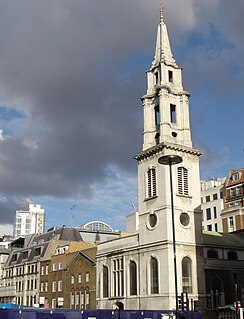
Saint Vedast Foster Lane or Saint Vedast-alias-Foster, a church in Foster Lane, in the City of London, is dedicated to St. Vedast, a French saint whose cult arrived in England through contacts with Augustinian clergy.

St Nicholas Cole Abbey is a church in the City of London located on what is now Queen Victoria Street. Recorded from the twelfth century, the church was destroyed in the Great Fire of London in 1666 and rebuilt by the office of Sir Christopher Wren. The church suffered substantial bomb damage from German bombs during the London Blitz in the Second World War and was reconstructed by Arthur Bailey in 1961–2.

All Hallows Bread Street was a parish church in the Bread Street ward of the City of London, England. It stood on the east side of Bread Street, on the corner with Watling Street. First mentioned in the 13th century, the church was destroyed in the Great Fire of London in 1666. The church was rebuilt by the office of Sir Christopher Wren and demolished in 1876.

All-Hallows-the-Great was a church in the City of London, located on what is now Upper Thames Street, first mentioned in 1235. Destroyed in the Great Fire of London of 1666, the church was rebuilt by the office of Sir Christopher Wren. All-Hallows-the-Great was demolished in 1894 when many bodies were disinterred from the churchyard and reburied at Brookwood Cemetery.

St. Bartholomew-by-the-Exchange was a church and parish in the City of London located on Bartholomew Lane, off Threadneedle Street. Recorded since the 13th century, the church was destroyed in the Great Fire of London in 1666, then rebuilt by Sir Christopher Wren. The rebuilt church was demolished in 1840.

St Benet Gracechurch, so called because a haymarket existed nearby (Cobb), was a parish church in the City of London. First recorded in the 11th century, it was destroyed in the Great Fire of London of 1666 and rebuilt by the office of Sir Christopher Wren. The church was demolished in 1868.

St Benet Fink was a church and parish in the City of London located on what is now Threadneedle Street. Recorded since the 13th century, the church was destroyed in the Great Fire of London of 1666, then rebuilt to the designs of Sir Christopher Wren. The Wren church was demolished between 1841 and 1846.
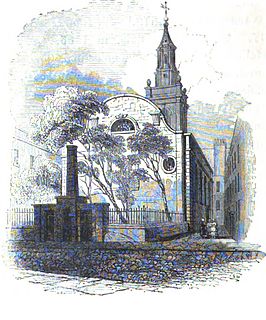
St Michael Bassishaw, or Basinshaw, was a parish church in Basinghall Street in the City of London, standing on land now occupied by the Barbican Centre complex. Recorded since the 12th century, the church was destroyed in the Great Fire of 1666, then rebuilt by the office of Sir Christopher Wren. The rebuilt church was demolished in 1900.

St. Mary Magdalen Old Fish Street was a church in Castle Baynard ward of the City of London, England, located on the corner of Old Fish Street and Old Change, on land now covered by post-War development. Recorded since the 12th century, the church was destroyed in the Great Fire of London of 1666, then rebuilt by the office of Sir Christopher Wren. The rebuilt church suffered damage to its roof from a fire in an adjacent warehouse in 1886. It was not repaired, and was finally demolished in 1893.

St Mildred, Poultry, was a parish church in the Cheap ward of the City of London dedicated to Anglo-Saxon Saint Mildred. It was rebuilt after the Great Fire of London, and demolished in 1872. St Mildred in the Poultry was the burial place of the writer Thomas Tusser. Some description of the church and its monuments is given in John Stow's Survey of London.

St Christopher le Stocks was a parish church on the north side of Threadneedle Street in the Broad Street Ward of the City of London. Of Medieval origin, it was rebuilt following the Great Fire of London in 1666, but demolished in 1781 to make way for an extension of the neighbouring Bank of England.
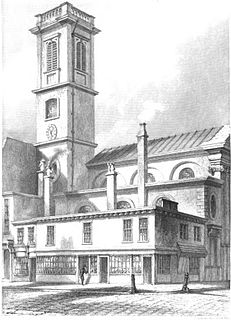
St Dionis Backchurch was a parish church in the Langbourn ward of the City of London. Of medieval origin, it was rebuilt after the Great Fire of London to the designs of Christopher Wren and demolished in 1878.
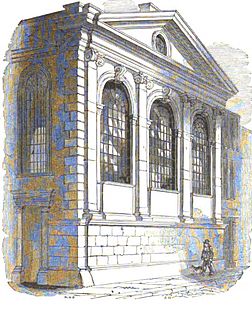
St Michael's Wood Street was a church and parish of medieval origin in Cripplegate Ward in the City of London, and is first mentioned in 1225 as St. Michael de Wudestrate. It stood on the west side of Wood Street, initially with a frontage on Huggin Lane but later on Wood Street itself.

St Mary Colechurch was a parish church in the City of London destroyed in the Great Fire of London in 1666 and not rebuilt.
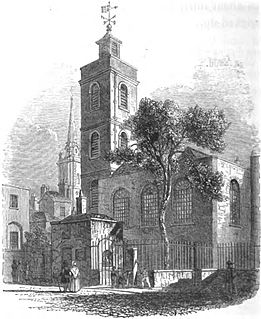
St James Duke's Place was an Anglican parish church in the Aldgate ward of the City of London It was established in the early 17th century, rebuilt in 1727 and closed and demolished in 1874.
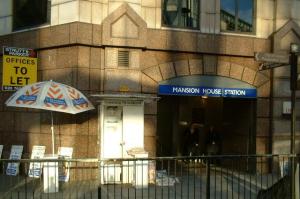
Holy Trinity the Less was a parish church in Knightrider Street in the City of London, destroyed in the Great Fire of London. Following the fire the site was used for a Lutheran church, which was eventually demolished in 1871 to make way for Mansion House underground station.

St Michael-le-Querne, also called St Michael ad Bladum, was a parish church in the Farringdon Within Ward in the City of London. It was destroyed in the Great Fire of London of 1666 and not rebuilt. The name is apparently a reference to a quern-stone as there was a corn market in the churchyard.
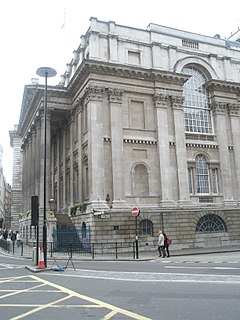
St Mary Woolchurch Haw was a parish church in the City of London, destroyed in the Great Fire of London of 1666 and not rebuilt. It came within the ward of Walbrook.




















